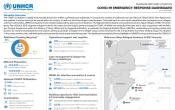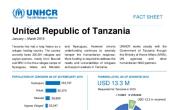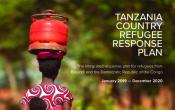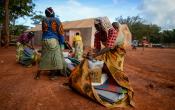United Republic of Tanzania
Operation: United Republic of Tanzania
Location
{"longitude":35,"latitude":-6,"zoom_level":0,"iso_codes":"'TZA'"}
By clicking on the icons on the map, additional information is displayed.
The boundaries and names shown and the designations used on this map do not imply official endorsement or acceptance by the United Nations.
Key Figures
| 2019 year-end results | |
| 100% | of refugees and asylum-seekers had access to primary health care in the camps. |
| 100% | of people of concern had access to an average of 21 liters of water per person per day in the three camps. |
| 100% | of survivors who reported incidents of sexual and gender-based violence (SGBV) were provided with psychosocial counselling and multi-sectoral assistance. |
| 89% | of school-aged children (aged 3-17) in the camps had access to education. |
| 2020 planning figures | |
| 100% | of reported SGBV related cases responded to and awareness on prevention and response conducted |
| 95% | of primary school-aged children enrolled in school |
| 90% | of refugee households’ needs for basic and domestic items met |
| 16% | of households with access to sustainable energy |
| 21 | liters of potable water per person per day made available |
More Information
People of Concern
12%
Decrease in
2019
2019
| 2019 | 295,595 |
| 2018 | 337,005 |
| 2017 | 521,282 |

[["Refugees",242171],["Asylum-seekers",29558],["Others of concern",23866]]
Loading ...
United Republic of Tanzania
< Back
2019
{"categories":[2015,2016,2017,2018,2019,2020],"budget":[134.15516444,108.50987822,137.1331802,125.8120637,126.04262139,150.66111859],"expenditure":[48.87004149,69.99019142,66.46673125,53.8762131,47.84617567,null]}
{"categories":[2015,2016,2017,2018,2019,2020],"p1":[118.73635308,96.04563581,126.70166642,122.59261362,123.85980609,147.59324689],"p2":[null,null,null,null,null,null],"p3":[15.41881136,12.46424241,10.43151378,3.21945008,2.1828153,3.0678717],"p4":[null,null,null,null,null,null]}
{"categories":[2015,2016,2017,2018,2019,2020],"p1":[42.24403878,65.51548653,61.88418214,51.28754876,46.42073671,null],"p2":[null,null,null,null,null,null],"p3":[6.62600271,4.47470489,4.58254911,2.58866434,1.42543896,null],"p4":[null,null,null,null,null,null]}
Loading ...
CHOOSE A YEAR
- 2014
- 2015
- 2016
- 2017
- 2018
- 2019
- 2020
Operational context
In 2019, UNHCR increased its advocacy efforts with stakeholders including donors, academia and government authorities in the United Republic of Tanzania (Tanzania). Following a change in senior management at the Refugee Services Department in the Ministry of Home Affairs, UNHCR engaged with new officials in order to agree on operational priorities and continued advocating for a favourable protection environment.While the Government confirmed its commitment to the Global Compact on Refugees, and despite having made a pledge at the Leaders’ Summit in 2016 to review refugee legislation to allow refugees to move outside the camps and to work, the policy of encampment was maintained. This resulted in a lack of livelihood opportunities, leaving refugees dependent on humanitarian assistance and at risk of exploitation and abuse.
The Government and UNHCR conducted a joint validation exercise of refugees and asylum-seekers, including registration of those who had not been registered since 2018. However, immediately after registration, new asylum-seekers were recorded as “inactive” in the relevant database, preventing them from accessing assistance and leaving them at risk of deportation. Following high-level advocacy, newly registered asylum-seekers were eventually granted access to assistance at the end of 2019 but without clear legal status.
Population trends
By the end of 2019, Tanzania hosted some 271,700 refugees and asylum-seekers mainly from Burundi and the Democratic Republic of Congo (DRC). Of the total registered population, 50% were female and 57% children. The majority of refugees and asylum seekers lived in three refugee camps, with a small urban population in Dar es Salaam.In 2019, no new arrivals were formally registered from Burundi or DRC, as the borders remained closed. UNHCR understood that some asylum-seekers found their way into the camps but were never registered by the Government (until the validation exercise when some were registered), some were pushed back at the border, while others managed to enter the territory but were deported without UNHCR being granted access to assess their claims.
Some 20,900 refugees repatriated to Burundi in 2019, bringing the total number of those who had repatriated since 2017 to nearly 78,800.
Key achievements
- Targets on SGBV awareness raising, prevention, mitigation, capacity building and psychosocial counselling were surpassed.
- UNHCR constructed 48 new classrooms in 2019.
- Access to comprehensive primary health care and medical referral care services was freely availed to all people of concern.
- The crude mortality rate (CMR) and under-five mortality (U5MR) rates were within the SPHERE minimum standards.
- Nearly 5,700 transitional shelters were constructed, contributing to a 23% increase in average shelter coverage (from 49% in 2018 to 71% in 2019). Some 2,500 refugee housing units were provided to people with specific needs.
Unmet needs
With the operation only 31% funded for 2019, the level of assistance and protection services was consequently limited.
- 51% of households did not have family latrines and only 250 grams of soap was provided in monthly distributions, as opposed to the standard 450 grams.
- 20% of refugees did not have adequate shelter and were living in dilapidated emergency shelters and tents.
- The operation was unable to implement activities to improve access to sustainable energy sources, resulting in communities engaging in environmentally degrading activities with the use of firewood as the main source of cooking fuel.
- Despite having access to primary health care, health facilities remained insufficient in all camps to cater for the camp population, with limited services for chronic and non-communicable diseases.
- Other unmet needs included limited support to foster care families, shortage of core relief items, insufficient cash support, and lack of specialized optical/dental services to meet the needs of the vulnerable, leading to negative coping mechanisms.
Working Environment
The United Republic of Tanzania has hosted refugees for over 50 years, and has shown unprecedented readiness to find local durable solutions for various groups.The transition of refugee registration system from UNHCR to the Government will take place in accordance with a phased plan. Resettlement will continue as part of a multi-year plan, albeit in smaller numbers and will continue to be used as a protection tool for people with specific needs.
Given the continued insecurity in eastern Democratic Republic of the Congo (DRC), only minimal prospects for voluntary repatriation for Congolese are expected. Since 2017, more than 45,000 Burundian refugees have been assisted to return voluntarily from the United Republic of Tanzania. Some 120,000 more from neighbouring countries are expected to return in 2019. While UNHCR is not promoting returns to Burundi at this time, it will continue working with the Government of Burundi and host countries to assist voluntary repatriation in safety and dignity for those who have made a free and informed choice to do so.
In 2019, UNHCR plans to find durable solutions for approximately 60,000 of 1972 Burundian refugees whose naturalization remains pending.
While opportunities to address the humanitarian and development nexus by engaging development actors and other relevant stakeholders remain, innovative approaches will need to be employed to improve the protection environment through the multi-year, multi-partner (MYMP) strategy process.
The refugee response in Tanzania is led and coordinated by the Government, mainly the Ministry of Home Affairs (MHA) through the Refugee Services Department and UNHCR, in close consultation with UN and NGO partners. UNHCR works with the UN Resident Coordinator, and other UN agencies through the Delivering as One initiative and participates in the UN Development Assistance Plan (UNDAP II) 2016-2021.
UNHCR continues to strengthen its engagement and partnership with the World Bank, the private sector, as well as with regional institutions such as the East African Community on refugee policies and border management, the International Conference on Greta Lakes Region on statelessness, as well as the Southern African Development Community on migration and reintegration. UNHCR also continues its work with a wide range of national and international NGOs in the United Republic of Tanzania.
Key priorities:
In 2019, UNHCR will focus on:- advocating with the Government for asylum space including emphasizing on ensuring voluntariness of the ongoing assisted voluntary repatriation to Burundi;
- seeking protection and solutions for refugees and asylum-seekers for both new arrivals and protracted refugee situation;
- improving services in all sectors rendered to refugees and asylum-seekers to meet minimum standards.























